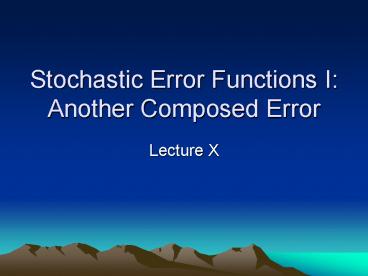Stochastic Error Functions I: Another Composed Error - PowerPoint PPT Presentation
1 / 20
Title:
Stochastic Error Functions I: Another Composed Error
Description:
Stochastic Error Functions I: Another Composed Error Lecture X Concept of the Composed Error To introduce the composed error term, we will begin with a cursory ... – PowerPoint PPT presentation
Number of Views:44
Avg rating:3.0/5.0
Title: Stochastic Error Functions I: Another Composed Error
1
Stochastic Error Functions I Another Composed
Error
- Lecture X
2
Concept of the Composed Error
- To introduce the composed error term, we will
begin with a cursory discussion of technical
efficiency which we develop more fully after the
dual.
3
- We start with the standard production function
- We begin by acknowledging that firms may not
produce on the efficient frontier
4
- We assume that TEi 1 with TEi 1 denoting a
technically efficient producer. - The above model presents all the error between
the firms output and the frontier as technical
inefficiency.
5
- The above model presents all the error between
the firms output and the frontier as technical
inefficiency. - Augmenting this model with the possibility that
random shocks may affect output that do not
represent inefficiency
6
Models of technical inefficiency without random
shocks.
- Building on the model of technical inefficiency
alone, we could estimate the production function
using a one-sided error specification alone. - Mathematical Programming (Goal Programming)
First we could solve two non-linear programming
problems
7
- First we could minimize the sum of the residuals
such that we constrain the residuals to be
positive
8
- which approximates the distribution function for
the exponential distribution with a log
likelihood function
9
- The second specification minimizes the sum of
square residuals such that the residual is
constrained to be positive
10
- which approximates the half-normal distribution
11
- Corrected Ordinary Least Squares
- Estimate the production function using ordinary
least squares, then adjust the estimated frontier
by adding a sufficient constant to the estimated
intercept to make all the error terms negative
12
- the estimated residuals are then
- This procedure simply shifts the production
function estimated with OLS upward, no
information on the inefficiency is used in the
estimation of the slope coefficients.
13
- Modified Ordinary Least Squares
- A related two step estimation procedure it to
again estimate the constant and slope parameters
using ordinary least squares, and then to fit a
secondary distribution function (i.e., the
half-normal, gamma, or exponential) to the
residuals.
14
- The expected value of the residuals for this
second distribution is then used to adjust the
constant of the regression and the residuals - In addition to the constant shift in the
production function addressed above, this
specification does not necessarily guarantee that
all the residuals will be negative.
15
Stochastic Frontier Specifications
- Adding both technical variation and stochastic
effects to the production model, we get
16
- The overall error term of the regression is
refereed to as the composed error - Assuming that the components of the random error
term are independent, OLS provides consistent
estimates of the slope coefficients, but not of
the constant.
17
- Further, OLS does not provide estimates of
producer-specific technical inefficiency. - However, OLS does provide a test for the possible
presence of technical inefficiency in the data - Specifically, if technical inefficiency is
present then ui lt 0 so that the distribution is
negatively skewed.
18
- Various tests for significant skewness are
available (Bera and Jarque), but in this
literature
19
Variable Parameter
Constant 4.58582
(0.05607)
Nitrogen 0.01265
(0.01179)
Phosphorous 0.01677
(0.00732)
Potash 0.01322
(0.00629)
20
(No Transcript)































